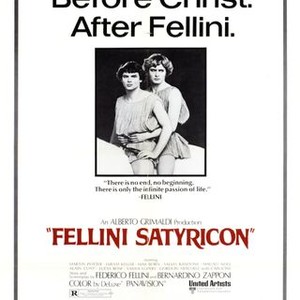

Stunning camerawork in deliberately garish colour from Giuseppe Rotunna, incomparable art direction, and some riveting music from Nini Rota aid Fellini in his principal task, which is simply to astonish and to widen the imagination. The rest are a vast gallery of gargoyles come to life, like the population of some terrible nightmare, wriggling under the foot of the dreamer. Beautiful boys wink lecherously, gorgeous girls (Capucine, Lucia Bose, and Donyale Luna) almost redress the balance, and there’s a notable hermaphrodite (Pasquale Baldassarre) for the in-betweens.
Still, it is a notable journey and the train waits long enough at various stations to allow some extraordinary excursions we progress from a brothel in the catacombs to Trimalchio’s feast in a purgatorial Roman Savoy from Lichas’s prison-like galley to the Minotaur’s pit where Encolpius complains that he is only a student and cannot be expected to beat the equivalent of Mick McManus. Its power is chiefly visual and what we see is frequently so stunning that one could often wish for more content and less context. This is one of the film’s strengths, and also its weakness. The links are Encolpius (Martin Potter) and his friend Ascyltus (Hiram Keller) whom we follow on adventures which allow Fellini so much scope for grotesquerie that fabulous images are glimpsed and thrown away in seconds. The fragments Fellini has chosen to embellish come from Apuleius and Juvenal as well as Petronius so that the whole becomes a sort of dream progression through which one dimly perceives points of reference, as if being told a half-remembered story. But Fellini’s real triumph is that sometimes, to our discomfort, he makes us see another eye peering at us. Of course, we’re looking through a keyhole like retarded adolescents. It seems to me at this moment a much more considerable achievement than thought - a concoction of such depth of imagination and command of style that one ought surely to be able to forgive what Richard Roud called its “near-prurient outsider’s view” of Petronius’s unholy Roman Empire. But I hope they find themselves in less of a quandary than I do, having written only last week rather disparagingly and now, after a second visit, wishing I hadn’t. Goodness knows how people are going to react to it. A t last the Fellini Satyricon has hit London, dubbed in English, evidently to its maker’s satisfaction, edited down a bit since Venice, 1969, and accommodated on a screen at the Prince Charles which is almost, but not quite, equal to its visual virtuosities.


 0 kommentar(er)
0 kommentar(er)
